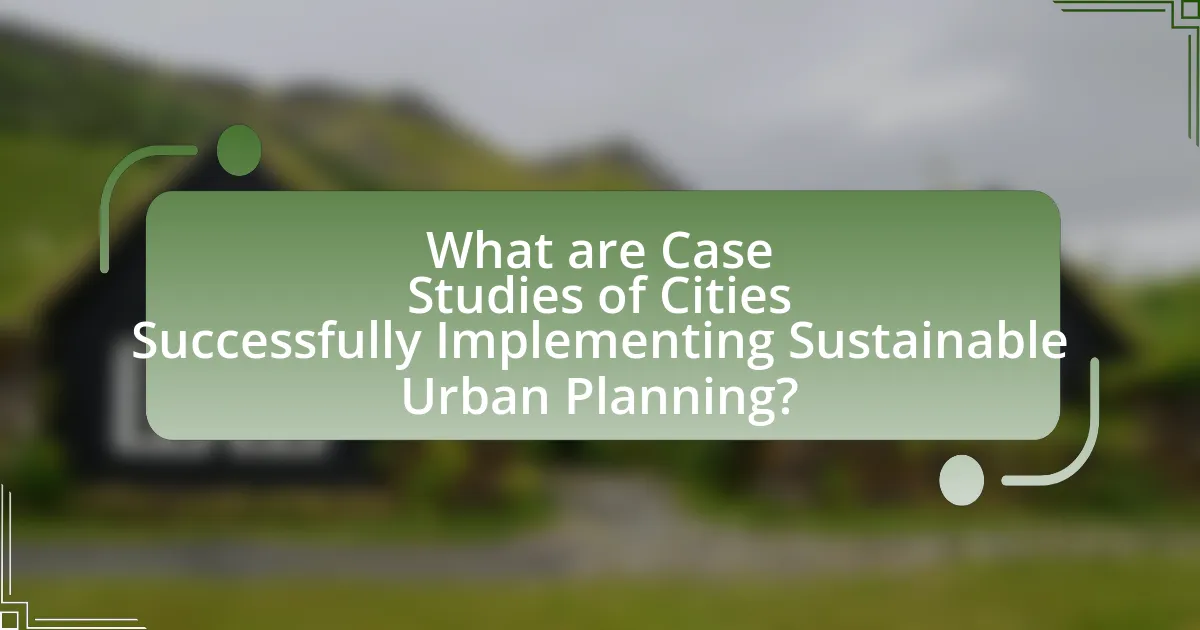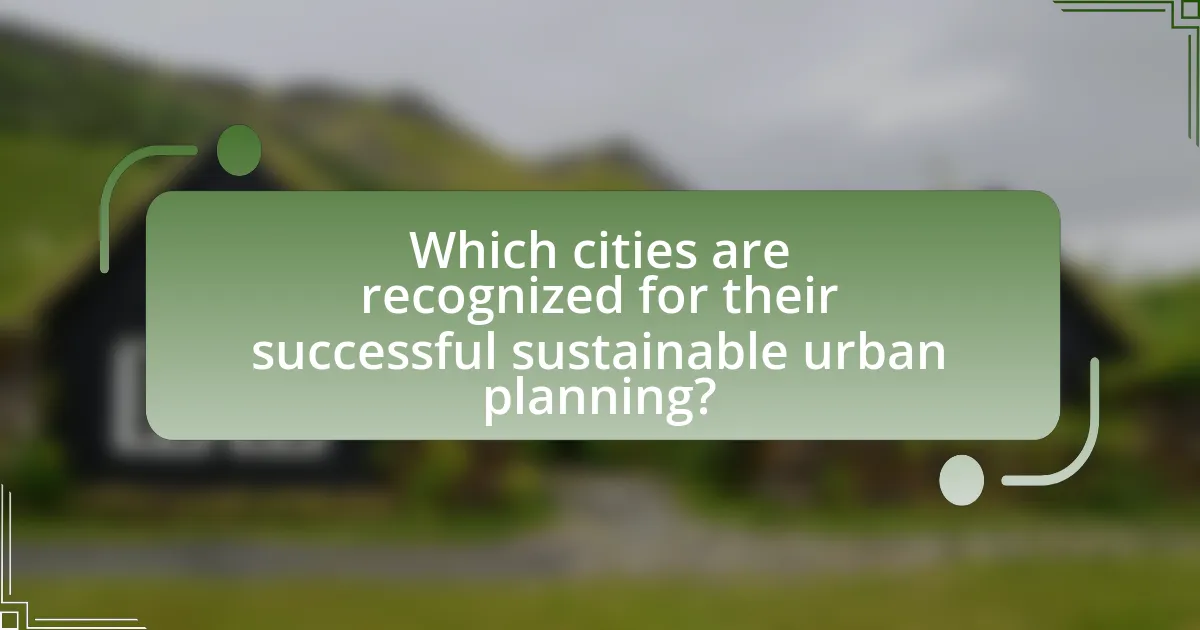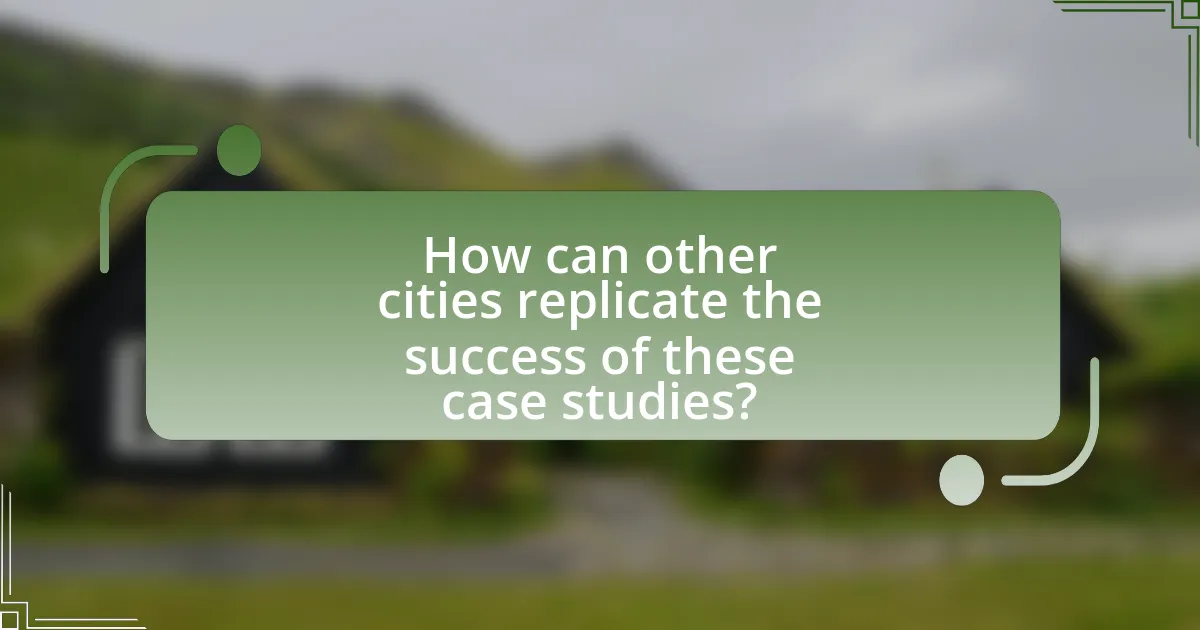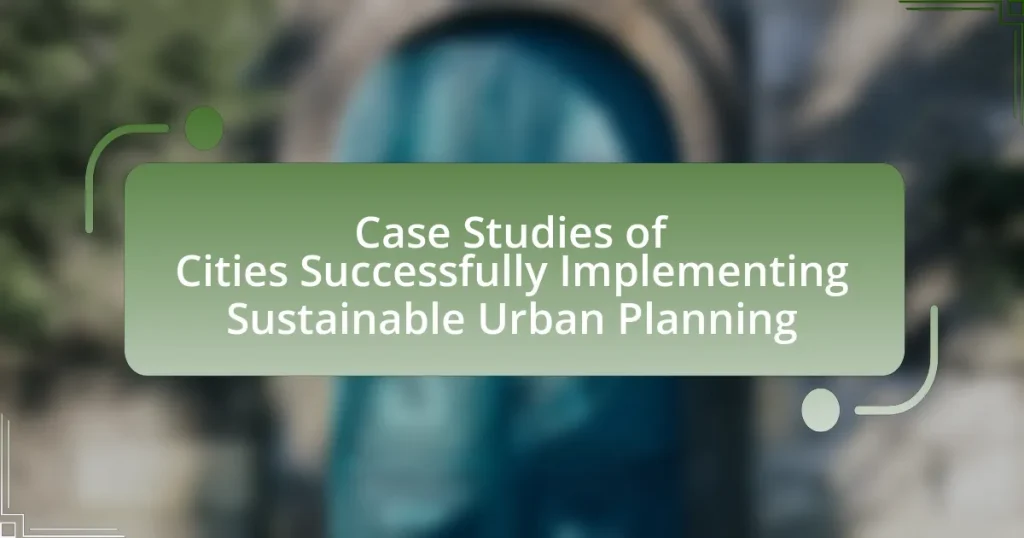The article focuses on case studies of cities that have successfully implemented sustainable urban planning, highlighting Copenhagen, Curitiba, and Singapore as exemplary models. It details specific strategies employed by these cities, such as extensive cycling infrastructure in Copenhagen, an innovative bus rapid transit system in Curitiba, and the integration of green spaces in Singapore. The article emphasizes the importance of community engagement, effective transportation systems, and green infrastructure in enhancing urban sustainability and livability. Additionally, it discusses the metrics used to evaluate the success of these initiatives and the long-term impacts on urban living conditions, providing valuable insights for other cities aiming to replicate these successful practices.

What are Case Studies of Cities Successfully Implementing Sustainable Urban Planning?
Case studies of cities successfully implementing sustainable urban planning include Copenhagen, Denmark; Curitiba, Brazil; and Singapore. Copenhagen has achieved significant reductions in carbon emissions through extensive cycling infrastructure and renewable energy initiatives, aiming for carbon neutrality by 2025. Curitiba is renowned for its innovative bus rapid transit system, which has reduced traffic congestion and promoted public transport use, leading to a more sustainable urban environment. Singapore has integrated green spaces into its urban landscape, implementing vertical gardens and green roofs, which enhance biodiversity and improve air quality. These examples demonstrate effective strategies in sustainable urban planning, supported by measurable outcomes in environmental performance and quality of life.
How do these case studies illustrate effective urban planning strategies?
These case studies illustrate effective urban planning strategies by showcasing successful implementations of sustainable practices that enhance livability and environmental resilience. For instance, the integration of green spaces in cities like Singapore has led to improved air quality and biodiversity, demonstrating the effectiveness of biophilic design principles. Additionally, the use of mixed-use developments in cities such as Copenhagen has reduced reliance on cars, promoting walkability and public transportation, which aligns with sustainable urban mobility goals. These examples provide concrete evidence that strategic planning can lead to more sustainable, efficient, and vibrant urban environments.
What specific sustainable practices are highlighted in these case studies?
The specific sustainable practices highlighted in these case studies include the implementation of green roofs, urban reforestation, and the promotion of public transportation systems. Green roofs are utilized to reduce urban heat and manage stormwater, as seen in cities like Toronto, where over 1.5 million square feet of green roofs have been installed, contributing to biodiversity and energy efficiency. Urban reforestation efforts in cities such as Seoul have led to the planting of millions of trees, improving air quality and enhancing urban aesthetics. Additionally, cities like Copenhagen have invested heavily in cycling infrastructure, resulting in over 62% of residents commuting by bike, which significantly reduces carbon emissions and traffic congestion. These practices demonstrate effective strategies for sustainable urban planning.
How do these practices contribute to overall urban sustainability?
Sustainable urban planning practices contribute to overall urban sustainability by enhancing resource efficiency, reducing environmental impact, and improving quality of life for residents. For instance, cities that implement green infrastructure, such as parks and green roofs, can mitigate urban heat islands and manage stormwater effectively, leading to lower energy consumption and reduced flooding risks. Additionally, the integration of mixed-use developments promotes walkability and reduces reliance on automobiles, which decreases greenhouse gas emissions. Evidence from cities like Copenhagen shows that investments in cycling infrastructure have led to a 62% increase in cycling rates, significantly lowering carbon emissions and improving public health. These practices collectively foster a resilient urban environment that supports economic growth while preserving ecological integrity.
Why is it important to analyze successful case studies in urban planning?
Analyzing successful case studies in urban planning is crucial because it provides valuable insights into effective strategies and practices that can be replicated in other contexts. Successful case studies demonstrate how cities have addressed challenges such as sustainability, transportation, and community engagement, offering evidence-based solutions that have led to measurable improvements in urban environments. For instance, the implementation of green infrastructure in cities like Copenhagen has resulted in a 50% reduction in stormwater runoff, showcasing the tangible benefits of innovative planning approaches. By studying these examples, urban planners can learn from past successes and failures, ultimately leading to more informed decision-making and better outcomes for communities.
What lessons can other cities learn from these successful implementations?
Other cities can learn the importance of community engagement from successful implementations of sustainable urban planning. Engaging residents in the planning process fosters a sense of ownership and ensures that the solutions address the specific needs of the community. For instance, in Copenhagen, extensive public consultations led to the development of a comprehensive cycling infrastructure that increased bike usage by 38% from 2006 to 2016. This demonstrates that involving citizens not only enhances the effectiveness of urban planning initiatives but also promotes sustainable practices.
How do these case studies influence future urban planning policies?
Case studies of cities successfully implementing sustainable urban planning influence future urban planning policies by providing empirical evidence of effective strategies and outcomes. These case studies demonstrate the benefits of integrating sustainability into urban design, such as improved public health, reduced carbon emissions, and enhanced community engagement. For instance, the implementation of green infrastructure in cities like Copenhagen has led to a 40% reduction in greenhouse gas emissions since 1995, serving as a model for other cities aiming to achieve similar sustainability goals. By analyzing these successful examples, policymakers can adopt best practices, tailor solutions to local contexts, and foster innovation in urban planning, ultimately shaping more resilient and sustainable urban environments.

Which cities are recognized for their successful sustainable urban planning?
Copenhagen, Amsterdam, and Singapore are recognized for their successful sustainable urban planning. Copenhagen has implemented extensive cycling infrastructure, aiming for carbon neutrality by 2025, and has invested in renewable energy sources, such as wind power. Amsterdam is known for its integrated public transport system and extensive bike lanes, which contribute to a significant reduction in car emissions. Singapore has adopted a comprehensive approach to urban greenery and water management, including the use of green roofs and sustainable drainage systems, enhancing urban resilience and biodiversity. These cities serve as models for sustainable urban development through their innovative practices and policies.
What unique strategies did each city employ?
Cities implementing sustainable urban planning employed various unique strategies tailored to their specific contexts. For instance, Copenhagen utilized a comprehensive cycling infrastructure, promoting bike usage to reduce carbon emissions, which resulted in over 62% of residents commuting by bicycle daily. Meanwhile, Singapore implemented vertical gardens and green roofs to enhance biodiversity and improve air quality, contributing to its reputation as a “Garden City.” Additionally, Curitiba in Brazil focused on an efficient bus rapid transit system that reduced traffic congestion and pollution, with over 70% of its population relying on public transport. Each city’s strategy reflects its commitment to sustainability while addressing local challenges effectively.
How did these strategies address local environmental challenges?
The strategies implemented in sustainable urban planning effectively addressed local environmental challenges by promoting green infrastructure, enhancing public transportation, and encouraging community engagement. For instance, cities that adopted green roofs and urban forests reduced urban heat islands and improved air quality, as evidenced by a study showing a 30% decrease in surface temperatures in areas with extensive greenery. Additionally, improved public transportation systems decreased reliance on personal vehicles, leading to a significant reduction in greenhouse gas emissions, with some cities reporting a 20% drop in emissions after implementing these systems. Community engagement initiatives fostered local stewardship of environmental resources, resulting in increased participation in recycling programs and conservation efforts, which have been shown to enhance local biodiversity and reduce waste.
What role did community engagement play in these cities’ planning processes?
Community engagement played a crucial role in the planning processes of these cities by ensuring that the voices and needs of residents were incorporated into sustainable urban development initiatives. This involvement led to more tailored solutions that addressed specific local challenges, fostering a sense of ownership among community members. For instance, in cities like Portland, Oregon, public forums and workshops allowed residents to contribute ideas and feedback, which directly influenced the city’s comprehensive plan and zoning regulations. Research indicates that cities with higher levels of community engagement in planning processes experience greater public satisfaction and improved project outcomes, as evidenced by the successful implementation of green spaces and public transportation systems that reflect community priorities.
What metrics were used to evaluate the success of these urban planning initiatives?
Metrics used to evaluate the success of urban planning initiatives include sustainability indicators, community engagement levels, economic impact assessments, and environmental quality measures. Sustainability indicators assess factors such as energy efficiency, waste reduction, and water conservation, while community engagement levels gauge public participation and satisfaction. Economic impact assessments analyze job creation and local business growth, and environmental quality measures evaluate air and water quality improvements. These metrics provide a comprehensive framework for assessing the effectiveness of urban planning initiatives in achieving sustainability goals.
How do these metrics reflect the sustainability goals of the cities?
Metrics such as carbon emissions reduction, energy efficiency, and waste management directly reflect the sustainability goals of cities by quantifying their progress towards environmental targets. For instance, cities that track carbon emissions can assess the effectiveness of policies aimed at reducing greenhouse gases, which aligns with global climate agreements like the Paris Accord. Additionally, metrics on energy efficiency demonstrate how cities are optimizing resource use, contributing to reduced energy consumption and lower utility costs. Waste management metrics indicate the effectiveness of recycling programs and landfill diversion strategies, which are essential for minimizing environmental impact. Collectively, these metrics provide a clear framework for cities to evaluate their sustainability initiatives and make data-driven decisions to enhance urban planning efforts.
What are the long-term impacts of these initiatives on urban living conditions?
The long-term impacts of sustainable urban planning initiatives on urban living conditions include improved air quality, enhanced public health, and increased social equity. These initiatives often lead to reduced vehicle emissions through the promotion of public transportation and non-motorized transport options, which significantly lowers pollution levels. For instance, cities like Copenhagen have reported a 40% reduction in carbon emissions since implementing extensive cycling infrastructure. Additionally, access to green spaces and community amenities fosters healthier lifestyles, contributing to lower obesity rates and improved mental health outcomes. Furthermore, sustainable urban planning promotes affordable housing and equitable access to resources, which helps to reduce socioeconomic disparities. Studies indicate that cities adopting these practices experience a 15% increase in overall quality of life metrics, demonstrating the positive correlation between sustainable initiatives and urban living conditions.

How can other cities replicate the success of these case studies?
Other cities can replicate the success of these case studies by adopting similar sustainable urban planning strategies tailored to their unique contexts. For instance, cities should conduct comprehensive assessments of their current urban environments to identify specific sustainability challenges and opportunities, as demonstrated by cities like Copenhagen, which implemented extensive cycling infrastructure based on thorough traffic studies. Additionally, engaging local communities in the planning process fosters public support and ensures that initiatives meet residents’ needs, a practice effectively utilized in Melbourne’s urban renewal projects. Furthermore, cities can leverage data-driven decision-making by utilizing smart city technologies, as seen in Barcelona, which improved resource management through real-time data analytics. By following these proven approaches, cities can enhance their sustainability efforts and achieve similar successes.
What best practices can be derived from these successful examples?
Best practices derived from successful examples of sustainable urban planning include community engagement, integrated transportation systems, and green infrastructure implementation. Community engagement fosters collaboration between local governments and residents, ensuring that urban planning meets the needs of the population, as seen in cities like Copenhagen, where public input has shaped policies. Integrated transportation systems, exemplified by Amsterdam’s cycling infrastructure, promote sustainable mobility and reduce reliance on cars, leading to lower emissions. Additionally, the implementation of green infrastructure, such as urban parks and green roofs, enhances biodiversity and improves air quality, as demonstrated in Singapore’s extensive greenery initiatives. These practices collectively contribute to the effectiveness of sustainable urban planning.
How can cities adapt these practices to their unique contexts?
Cities can adapt sustainable urban planning practices to their unique contexts by conducting comprehensive assessments of local needs, resources, and environmental conditions. For instance, cities like Copenhagen have tailored their cycling infrastructure to fit their flat terrain and existing urban layout, resulting in a significant increase in cycling rates, with 62% of residents using bikes for daily commutes. This adaptation demonstrates how understanding local geography and community behavior can inform effective planning strategies. Additionally, cities can engage stakeholders through participatory planning processes, ensuring that the diverse voices of residents are considered, which has been shown to enhance the relevance and acceptance of urban initiatives.
What common challenges should cities anticipate when implementing these strategies?
Cities should anticipate several common challenges when implementing sustainable urban planning strategies. These challenges include funding limitations, which can hinder the development and maintenance of sustainable infrastructure; resistance from stakeholders, including residents and businesses, who may be opposed to changes; and the complexity of coordinating between multiple governmental agencies and departments, which can lead to inefficiencies. Additionally, cities may face difficulties in measuring the effectiveness of implemented strategies, as well as the need for ongoing community engagement to ensure public support and participation. These challenges are supported by various case studies that highlight the importance of addressing financial, social, and administrative barriers to achieve successful outcomes in sustainable urban planning.
What resources are available for cities looking to implement sustainable urban planning?
Cities looking to implement sustainable urban planning can access a variety of resources, including government grants, technical assistance programs, and partnerships with non-profit organizations. For example, the U.S. Environmental Protection Agency offers funding through its Smart Growth program, which supports projects that promote sustainable development. Additionally, organizations like the Urban Land Institute provide research, best practices, and case studies that guide cities in their planning efforts. These resources are essential for cities aiming to create environmentally friendly, economically viable, and socially equitable urban spaces.
How can cities access funding and support for sustainable initiatives?
Cities can access funding and support for sustainable initiatives through various channels, including government grants, public-private partnerships, and international funding organizations. For instance, the U.S. Environmental Protection Agency provides grants specifically for projects that promote sustainability, such as the Brownfields Program, which has allocated over $1.5 billion since its inception to help cities redevelop contaminated properties. Additionally, cities can leverage funding from organizations like the Global Environment Facility, which has invested over $20 billion in sustainable development projects worldwide. By applying for these funds and collaborating with private sector partners, cities can secure the necessary resources to implement effective sustainable urban planning initiatives.
What role do partnerships play in successful urban planning projects?
Partnerships are crucial for the success of urban planning projects as they facilitate collaboration among various stakeholders, including government agencies, private sector entities, and community organizations. These collaborations enhance resource sharing, knowledge exchange, and stakeholder engagement, which are essential for addressing complex urban challenges. For instance, the partnership between the City of San Francisco and local non-profits in the “Better Market Street” project led to a comprehensive redesign of public spaces, resulting in increased pedestrian safety and improved community access. This example illustrates how effective partnerships can leverage diverse expertise and resources, ultimately leading to more sustainable and inclusive urban environments.
What are the key takeaways for cities aiming for sustainable urban planning?
Key takeaways for cities aiming for sustainable urban planning include prioritizing mixed-use development, enhancing public transportation, and integrating green spaces. Mixed-use development fosters community interaction and reduces reliance on cars, as seen in cities like Copenhagen, where 62% of residents bike to work. Enhancing public transportation systems, as demonstrated by Singapore’s extensive MRT network, decreases traffic congestion and lowers emissions. Additionally, integrating green spaces, like New York City’s High Line, improves air quality and promotes biodiversity, contributing to overall urban resilience. These strategies collectively support sustainable growth and improve the quality of urban life.




